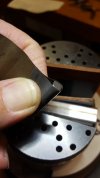pmace
Elite Cafe Member
I messed up and put some lightly scribed border lines where they shouldn't be. It's a steel practice plate so they can be "erased" with no harm. I don't want to take it to the belt sander and start over, just make the offending lines go away.
Sanding takes quite a while but leaves a nice finish. The same grit with a stone cuts much faster but leaves a dull finish, even with a much finer grit. Also there are more scratches to get out at the next higher grit. I'm using standard Artco 1/4" square "Special" stones (400, 600, 1200) and 3-in-1 oil.
Why do stones perform so poorly? Am I doing something wrong or is that just the nature of the beast?
Sanding takes quite a while but leaves a nice finish. The same grit with a stone cuts much faster but leaves a dull finish, even with a much finer grit. Also there are more scratches to get out at the next higher grit. I'm using standard Artco 1/4" square "Special" stones (400, 600, 1200) and 3-in-1 oil.
Why do stones perform so poorly? Am I doing something wrong or is that just the nature of the beast?







